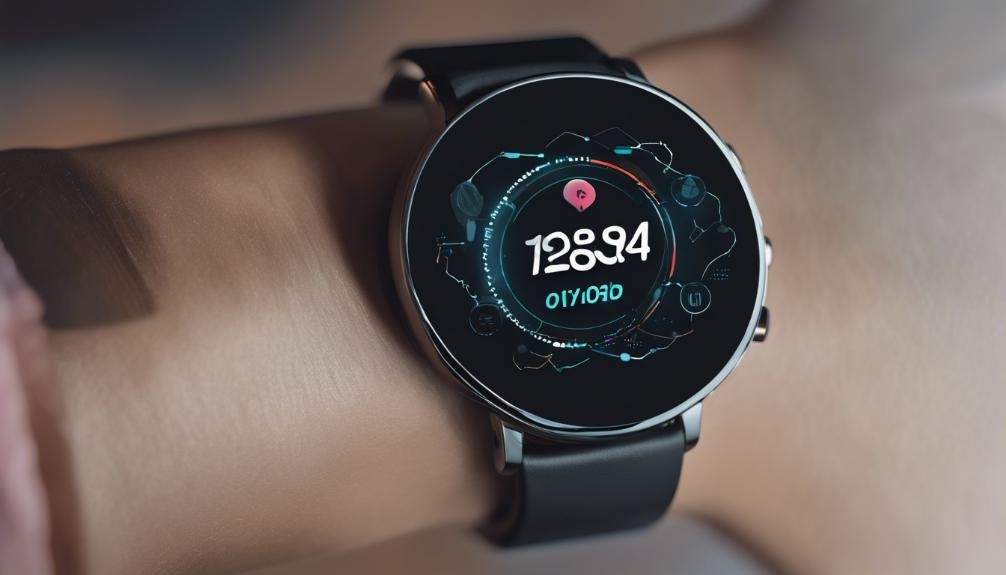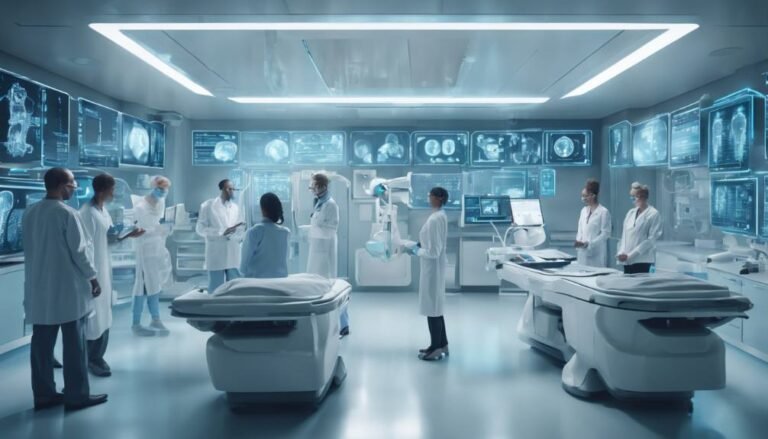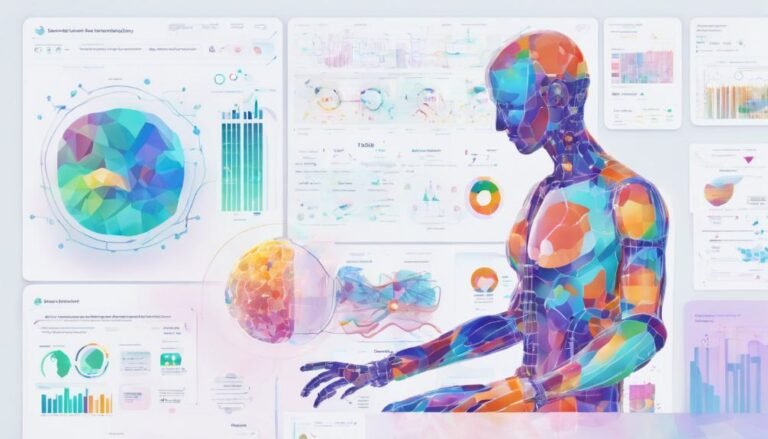AI for Remote Patient Monitoring
Imagine AI as a silent guardian, constantly observing and analyzing the intricate dance of data streaming from a patient's wearable devices. Envision this unseen sentinel detecting subtle shifts in key signs, alerting healthcare providers to potential health concerns before they escalate. The seamless integration of AI into remote patient monitoring holds immense promise, revolutionizing how healthcare is delivered. But how exactly does this technology navigate the complexities of real-time patient data and translate it into actionable insights for clinicians? Let's explore the intricate web of AI-driven remote monitoring and its impact on patient care.
Key Takeaways
- AI analyzes data for health trends.
- Enables real-time monitoring of vital signs.
- Assists in early detection of health issues.
- Enhances monitoring efficiency and accuracy.
- Provides personalized care plans based on data analysis.
Role of AI in Monitoring
AI plays an essential role in remote patient monitoring by continuously analyzing data to detect patterns and anomalies that can help healthcare providers make timely interventions.
Through the use of AI algorithms, real-time monitoring of patients' crucial signs, symptoms, and overall health status becomes more efficient and accurate.
AI algorithms sift through vast amounts of data collected from wearable devices, sensors, and patient reports to identify trends that might indicate a decline in health or the onset of a medical issue.
Benefits of Remote Monitoring
You'll discover that remote patient monitoring offers you enhanced patient care by providing continuous oversight of crucial health parameters outside traditional healthcare settings. This proactive approach leads to improved treatment outcomes as healthcare providers can intervene promptly based on real-time data, leading to better health management.
Additionally, remote monitoring contributes to efficient healthcare delivery by reducing hospital readmissions and unnecessary clinic visits through timely interventions and personalized care plans.
Enhanced Patient Care
Remote patient monitoring through AI technology offers a multitude of benefits that greatly enhance the level of care patients receive. By enabling remote diagnostics and personalized care, AI enhances patient care by allowing healthcare providers to monitor patients' health conditions from a distance.
Continuous monitoring of essential signs and other health data in real-time enables healthcare teams to detect any potential issues early on, leading to proactive interventions. This proactive approach allows for timely adjustments in treatment plans, medication dosages, or lifestyle recommendations, leading to better health outcomes for patients.
Moreover, AI-powered remote patient monitoring systems can analyze vast amounts of patient data swiftly and accurately, providing healthcare providers with valuable insights into each patient's unique health needs. This personalized approach to care ensures that patients receive tailored treatment plans that consider their specific health conditions and requirements.
Improved Treatment Outcomes
Enhancing treatment outcomes, remote patient monitoring technology leveraging AI capabilities demonstrates significant benefits in improving patient health management.
By enhancing treatment effectiveness through continuous monitoring and data analysis, AI-powered remote monitoring systems can provide personalized insights and interventions tailored to each patient's unique needs. This personalized approach not only guarantees that patients receive timely and appropriate care but also helps in preventing complications and managing chronic conditions more effectively.
Moreover, remote monitoring promotes patient engagement by involving individuals in their care process. Patients can actively participate in monitoring their health metrics, receiving real-time feedback, and communicating with healthcare providers without the need for frequent in-person visits. This increased engagement often leads to better treatment adherence and outcomes.
Additionally, remote monitoring improves healthcare access by breaking down geographical barriers and enabling patients to receive quality care regardless of their location. This technology facilitates early detection of health issues, timely interventions, and continuous support, ultimately resulting in improved treatment outcomes and enhanced overall patient well-being.
Efficient Healthcare Delivery
By leveraging advanced AI capabilities, remote patient monitoring technology streamlines healthcare delivery processes, resulting in more efficient and effective patient care management. Telehealth integration plays an essential role in this efficiency by enabling seamless communication between patients and healthcare providers.
Through remote monitoring solutions, healthcare professionals can remotely track vital signs, medication adherence, and symptom progression, allowing for timely interventions and personalized care plans.
Remote patient engagement is enhanced through continuous monitoring and real-time feedback, fostering a sense of empowerment and involvement in one's healthcare journey. This increased engagement often leads to improved health outcomes and higher patient satisfaction rates.
Additionally, remote monitoring contributes to better healthcare access for individuals in rural or underserved areas, where traditional healthcare services may be limited.
Challenges in Implementation
You must address data privacy concerns when implementing AI for remote patient monitoring to guarantee compliance with regulations like HIPAA and GDPR.
Additionally, technical infrastructure requirements such as secure networks and interoperability between systems pose significant challenges that need careful consideration and planning.
Overcoming these obstacles is vital for the successful adoption and integration of AI technologies in remote patient monitoring programs.
Data Privacy Concerns
Addressing data privacy concerns is paramount when implementing AI for remote patient monitoring due to the sensitive nature of healthcare information and the need to guarantee confidentiality and compliance with regulations. Ethical considerations and security measures play an essential role in safeguarding patient data.
Ensuring robust data protection mechanisms is critical to prevent unauthorized access or breaches. Patient consent is another significant aspect, where individuals must be informed about how their data will be used and have the opportunity to provide explicit consent.
Healthcare organizations must adhere to strict guidelines such as the Health Insurance Portability and Accountability Act (HIPAA) to maintain patient confidentiality and privacy. Implementing encryption protocols, secure networks, and access controls are essential security measures to protect patient data from cyber threats.
Continuous monitoring and audits can help identify and address any vulnerabilities in the system to uphold data privacy standards.
Technical Infrastructure Requirements
To effectively implement AI for remote patient monitoring, ensuring the technical infrastructure meets the requirements poses significant challenges that need careful consideration and planning. Network connectivity plays an important role in transmitting real-time patient data securely. Reliable internet access is essential for seamless data transmission between monitoring devices and healthcare providers. Data security measures must be strong to safeguard sensitive patient information from unauthorized access.
Device compatibility is another critical aspect to address. Different monitoring devices used by patients may require various software integrations to guarantee seamless data collection and analysis. Scalability is necessary to accommodate the increasing volume of data generated by remote patient monitoring systems. The infrastructure must be capable of handling a growing number of connected devices and the data they generate.
Addressing these technical infrastructure requirements is fundamental to the successful implementation of AI for remote patient monitoring. By prioritizing network connectivity, data security, device compatibility, and scalability, healthcare providers can deliver efficient and secure remote monitoring services to patients.
Enhancing Healthcare Interventions
Implementing AI technology in remote patient monitoring has shown promising results in enhancing healthcare interventions by providing real-time data analysis and personalized care. AI-driven interventions play an essential role in optimizing patient outcomes through continuous monitoring and analysis of vital signs, symptoms, and treatment responses. This proactive approach allows healthcare providers to intervene promptly and tailor interventions based on individual patient needs.
Healthcare technology integrated with AI has revolutionized patient engagement by enabling remote monitoring that guarantees constant connectivity between patients and healthcare professionals. Through wearable devices and mobile apps, patients can actively participate in their care by tracking their progress, receiving personalized health insights, and accessing educational resources.
This level of patient engagement fosters a collaborative relationship between patients and healthcare providers, leading to improved adherence to treatment plans and better health outcomes.
Future Trends in Patient Monitoring
Future advancements in patient monitoring technology are poised to revolutionize healthcare practices by incorporating innovative features for enhanced remote healthcare management. Wearable technology is becoming increasingly sophisticated, allowing for continuous monitoring of essential signs and health metrics outside traditional healthcare settings. These devices enable individuals to track their health in real-time, providing valuable data for healthcare providers to remotely assess their patients' well-being.
Telehealth integration is another key trend in patient monitoring, facilitating seamless communication between patients and healthcare professionals. Remote diagnostics are now possible through advanced monitoring devices, allowing for the early detection of health issues and timely interventions. Virtual consultations are on the rise, offering patients the convenience of receiving medical advice from the comfort of their homes.
These future trends in patient monitoring not only enhance the quality of care for individuals but also improve healthcare efficiency by reducing the need for frequent in-person visits.
As technology continues to evolve, the integration of wearable devices, telehealth solutions, remote diagnostics, and virtual consultations will play a pivotal role in shaping the future of patient monitoring.
Ai-Driven Predictive Analytics
Harnessing the power of artificial intelligence, predictive analytics in healthcare is revolutionizing patient monitoring by forecasting potential health outcomes based on data analysis. Through machine learning algorithms, predictive analytics processes vast amounts of patient data to identify patterns and trends that can predict future health events. By utilizing historical health records, important signs, and other relevant information, healthcare providers can anticipate potential complications or changes in a patient's condition before they occur. This proactive approach enables early interventions, personalized treatment plans, and improved patient outcomes.
Predictive analytics plays a significant role in enhancing patient monitoring by offering real-time insights into individual health trajectories. It assists in identifying high-risk patients, optimizing resource allocation, and reducing healthcare costs by preventing unnecessary hospital admissions or emergency room visits. By continuously analyzing data and updating predictions, healthcare professionals can tailor their care strategies to meet each patient's specific needs effectively.
As technology advances, predictive analytics will continue to refine healthcare predictions, ultimately leading to more precise diagnoses, timely interventions, and better overall patient care.
Improving Patient Outcomes
To enhance patient outcomes, optimizing the use of artificial intelligence in remote patient monitoring is essential for delivering personalized and effective healthcare interventions. Remote monitoring efficiency plays a vital role in ensuring timely intervention and management of patient conditions.
AI-driven personalized care allows for tailored treatment plans based on individual patient data, leading to improved outcomes. By incorporating AI algorithms, healthcare providers can analyze patient information in real-time, enabling proactive decision-making and intervention when necessary. This real-time analysis enhances treatment effectiveness and reduces the likelihood of adverse events by predicting potential issues before they escalate.
Moreover, patient engagement is greatly increased through AI-driven remote monitoring systems. Patients can actively participate in their care by receiving personalized insights and feedback, promoting adherence to treatment plans and lifestyle modifications. This higher level of patient engagement has been shown to positively impact health outcomes, as patients feel empowered and supported in managing their health.
Conclusion
To sum up, AI has revolutionized remote patient monitoring, offering real-time insights and interventions for improved healthcare outcomes.
By harnessing the power of predictive analytics and personalized care plans, healthcare providers can deliver proactive and tailored interventions to patients.
Embrace the advancements in AI-driven remote monitoring to enhance patient care, optimize healthcare delivery, and ultimately, save lives.
The future of healthcare lies in the hands of innovation and technology – seize this opportunity for better patient outcomes.







